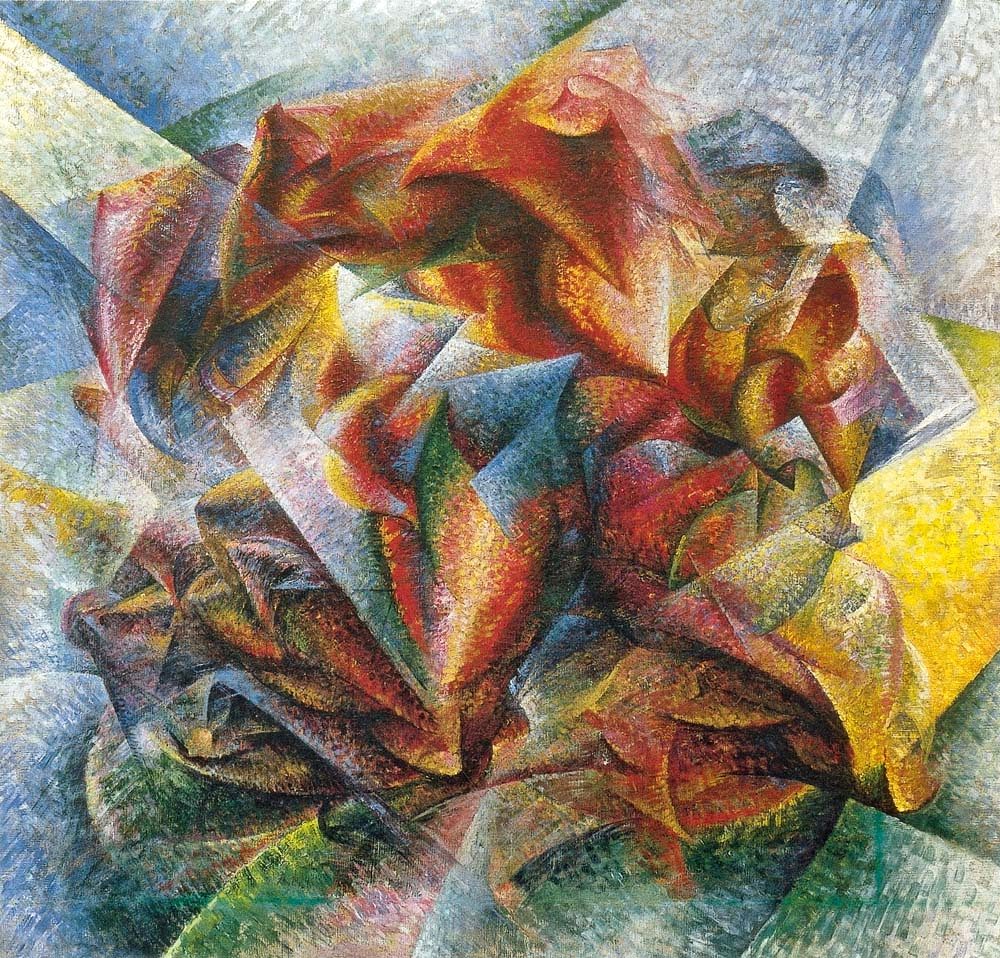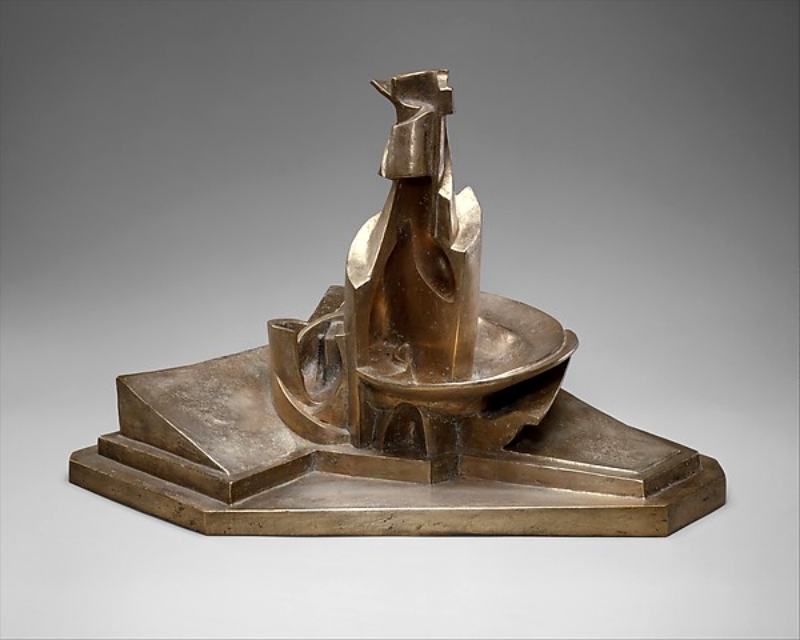Umberto Boccioni
Simultaneous-visions
Umberto Boccioni
Dinamismo del ciclista
Umberto Boccioni
Umberto Boccioni
Sviluppo della bottiglia nello spazio
Umberto Boccioni
Unique Forms of Continuity in Space' 1913

Umberto Boccioni
1882, Reggio Calabria, 1916, Verona,
Biography
Umberto Boccioni was born in 1882 in Reggio
Calabria, a rural region on the southern
tip of Italy. His parents had originated
from the Romagna region, further north. As
a young boy, Boccioni and his family moved
frequently, eventually settling in the Sicilian
city of Catania in 1897, where he received
the bulk of his secondary education. There
is little evidence to suggest he had any
serious interest in the fine arts until 1901,
at which time he moved from Catania to Rome
and enrolled at the Accademia di Belle Arti
di Roma (Academy of Fine Arts, Rome).
It was in Rome that Boccioni first connected
with his future Futurist collaborator Gino
Severini. Both studied under Giacomo Balla,
who was renowned as a Divisionist painter,
and Boccioni became a loyal student of the
style. During these years he also continued
his travels in Italy and beyond; he visited
Paris for an extended period, where he encountered
Impressionism for the first time, and followed
this with a sojourn to Russia.
During this period, much of the art being
produced in Italy was, to Boccioni's mind,
rather provincial. In the city of Milan,
however, there existed a forward-thinking
society of young artists known as the Famiglia
Artistica. So, in 1907, Boccioni moved to
Milan, where he met Filippo Tommaso Marinetti,
the Symbolist poet and theorist. Two years
later, on February 20, 1909, Marinetti published
the first Futurist manifesto on the front
page of the established French newspaper
Le Figaro. It quickly attracted followers,
among them Boccioni, Severini, Balla, Carlo
Carra and Luigi Russolo. But in the years
that followed, Boccioni proved to be Futurism's
most outspoken proponent and foremost theorist,
not to mention primarily responsible for
applying Marinetti's example to the visual
arts.
The beginning of Futurism coincided with
Boccioni's most prolific period as an artist.
On February 11, 1910, under the leadership
of Boccioni, the "Manifesto of Futurist
Painters" was published by Marinetti's
magazine Poesia, and was signed by Severini,
Balla and others. Addressed to the "Young
Artists of Italy," this new manifesto,
much like its predecessor, attacked institutions
like museums and libraries, which the Futurists
now considered redundant. Boccioni and the
Futurists were aiming at one of the Italy's
principle claims to prestige, its classical
past, which they considered a hindrance to
the country's development as a modern power.
Later on in the same year Boccioni published
the "Technical Manifesto of Futurist
Painting," also through Marinetti's
Poesia. He declared "That all subjects
previously used must be swept aside in order
to express our whirling life of steel, of
pride, of fever and of speed."
As a young artist, Boccioni had chosen subjects
that simply caught his eye, but as a Futurist,
he selected subjects as vehicles for painterly
theories. One subject that often inspired
him was the city, and it is explored in works
like The Forces of the Street and The Street
Enters the House (both 1911).
In 1912, the Futurist group held an impressive
exhibition of paintings at the Bernheim-Jeune
in Paris. The centerpiece of Boccioni's contribution
was a group of three paintings entitled States
of Mind I-III: The Farewells, Those Who Stay,
and Those Who Go (all 1911), considered by
many to be the artist's most ambitious work
thus far. In States of Mind, he attempted
to abandon the dependence on any descriptive
reality, opting instead to, as he put it,
"[have the] colors and forms ... express
themselves." In short, Boccioni designed
these works to express the Futurist mind-set,
in which the past had no bearing on how the
artist viewed the world around him.
While in Paris, Boccioni visited various
artists' studios, including those of Braque,
Brancusi, Archipenko and Duchamp-Villon.
What he saw encouraged him to apply his principles
to sculpture, resulting in works like The
Development of a Bottle in Space (1912) and
Unique Forms of Continuity in Space (1913).
This new interest also led him to write the
"Manifesto of Futurist Sculpture."
In 1913, Boccioni began contributing to the
experimental newspaper Lacerba, which had
been founded by the Florentine author and
Futurist Giovanni Papini (Lacerba published
70 issues between January 1, 1913 and May
22, 1915). With this newspaper, Boccioni
and others now had a publication exclusively
devoted to promoting the movement's ideas.
In April of the following year, Boccioni
published his book Futurist Painting and
Sculpture, by far the most comprehensive
account of Futurist artistic theory written
by a founding member.
In 1914, the Great War began and quickly
spread throughout Europe, and its remarkable
ferocity very closely resembled the cleansing
violence that the Futurists had long called
for. So, in July 1915, Boccioni, along with
Marinetti, Russolo and several other Futurists,
enrolled with the Lombard Volunteer Cyclist
Battalion.
The battalion was disbanded in December later
that year and during a leave of absence from
the war, Boccioni continued to paint, write
and lecture. He was called back into service
in June 1916, and stationed outside Verona
with an artillery brigade. During a training
exercise, Boccioni was thrown from his horse
and trampled. Still a young man of just thirty-three,
Boccioni succumbed to injuries and died a
day later on August 17.
THE FUTURISM
Although the Futurist movement is most associated
with its founder, Filippo Tommaso Marinetti,
its artistic direction owes much to Umberto
Boccioni. He is responsible for producing
the seminal texts on Futurist art, and was
by and large the movement's most talented,
technically proficient, and best educated
artist. Despite the brevity of his career,
he became a prolific student of avant-garde
styles, while simultaneously striving to
create something entirely novel: an art that
uniquely expressed the speed, dynamism and
tragedy of modern-day life.
Futurism began its transformation of Italian
culture on February 20th, 1909, with the
publication of the Futurist Manifesto, authored
by writer Filippo Tommaso Marinetti.
It appeared on the front page of Le Figaro,
which was then the largest circulation newspaper
in France, and the stunt signaled the movement's
desire to employ modern, popular means of
communication to spread its ideas. The group
would issue more manifestos as the years
passed, but this summed up their spirit,
celebrating the "machine age",
the triumph of technology over nature, and
opposing earlier artistic traditions. Marinetti's
ideas drew the support of artists Umberto
Boccioni, Giacomo Balla, Gino Severini, and
Carlo Carrą, who believed that they could
be translated into a modern, figurative art
which explored properties of space and movement.
The movement initially centered in Milan,
but it spread quickly to Turin and Naples,
and over subsequent years Marinetti vigorously
promoted it abroad.
The Italian group was slow to develop a distinct
style. In the years prior to the emergence
of the movement, its members had worked in
an eclectic range of styles inspired by Post-Impressionism,
and they continued to do so. Severini was
typical in his interest in Divisionism, which
involved breaking down light and color into
a series of stippled dots and stripes, and
fracturing the picture plane into segments
to achieve an ambiguous sense of depth. Divisionism
was rooted in the color theory of the 19th
century, and the Pointillist works of painters
such as Georges Seurat.
In 1911, Futurist paintings were exhibited
in Milan at the Mostra d'arte libera, and
invitations were extended to "all those
who want to assert something new, that is
to say far from imitations, derivations and
falsifications." The paintings featured
threadlike brushstrokes and highly keyed
color that depicted space as fragmented and
fractured. Subjects and themes focused on
technology, speed, and violence, rather than
portraits or simple landscapes. Among the
paintings was Boccioni's The City Rises (1910),
a picture which can claim to be the first
Futurist painting by virtue of its advanced,
Cubist-influenced style. Public reaction
was mixed. French critics from literary and
artistic circles expressed hostility, while
many praised the innovative content.
Boccioni's encounter with Cubist painting
in Paris had an important influence on him,
and he carried this back to his peers in
Italy. Nevertheless, the Futurists claimed
to reject the style, since they believed
it was too preoccupied by static objects,
and not enough by the movement of the modern
world. It was their fascination with movement
that led to their interest in chrono-photography.
Balla was particularly enthusiastic about
the technology, and his pictures sometimes
evoke fast-paced animation, with objects
blurred by movement. As stated by the Technical
Manifesto of Futurist Painting, "On
account of the persistency of an image upon
the retina, moving objects constantly multiply
themselves; their form changes like rapid
vibrations in their mad career. Thus a running
horse has not four legs, but twenty, and
their movements are triangular." Rather
than perceiving an action as a performance
of a single limb, Futurists viewed action
as the convergence in time and space of multiple
extremities.
In 1913, Boccioni used sculpture to further
articulate Futurist dynamism. Unique Forms
of Continuity in Space (1913) exemplifies
vigorous action as well as the relationship
between object and environment. The piece
was a breakthrough for the Futurist movement,
but after 1913 the movement began to break
apart as its members developed their own
personal positions. In 1915, Italy entered
World War I; by its end, Boccioni and the
Futurist architect Antonio Sant'Elia perished.
Following the war, the movement's center
shifted from Milan to Rome; Severini continued
to paint in the distinctive Futurist style,
and the movement remained active in the 1920s,
but the energy had passed from it.
Nevertheless, Futurism sparked important
developments outside Italy. A synthesis of
Parisian Cubism and Italian Futurism was
particularly influential in Russia from around
1912 until 1920, inspiring artists including
Kazimir Malevich, Liubov Popova, Natalia
Goncharova and David Burliuk. The developments
in Russia made the movement very distinct
from the Italian strain, and different aspects
of it are often described as Rayonist, or
Cubo-Futurist. Cubo-Futurism was also an
influence on English art, where it gave rise
to the Vorticist movement, which embraced
philosopher T.E. Hulme, poet Ezra Pound,
and artists Christopher Nevinson, Wyndham
Lewis, David Bomberg and Jacob Epstein. Although
the impact of Italian Futurism was concentrated
in the visual arts, it did inspire artists
in other media: Vladimir Mayakovsky was important
in developing a Futurist literature in Russia;
the Italian architect Antonio Sant'Elia developed
a Futurist architecture, and is said to have
penned a manifesto on the subject (his designs
may have influenced the sets of Ridley Scott's
film Bladerunner (1982)); and Luigi Russolo
shifted from painting to creating musical
instruments, and later wrote the manifesto
"The Art of Noises" (1913), which
has been a significant reference point for
avant-garde music ever since. Although much
of the energy had left the movement by the
1920s, the Futurist aesthetic also became
part of the mix of modernist styles that
inspired Art Deco.
THE FUTURISM
IN ARTE EST LIBERTAS
ARTENCYCLOPAEDIA
MOVEMENTS-ARTISTS






